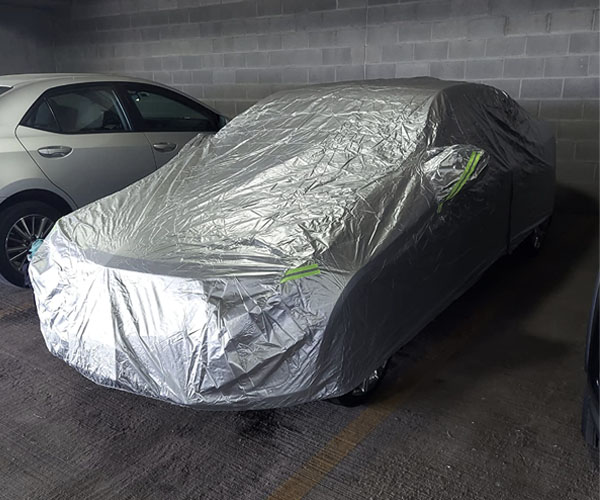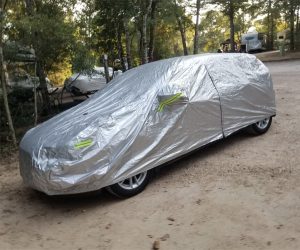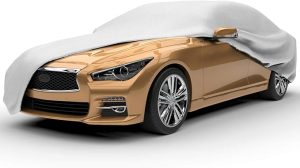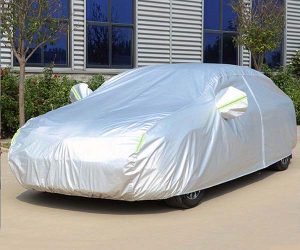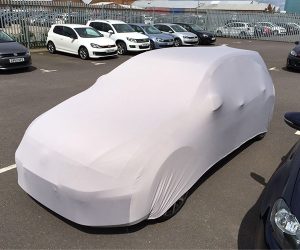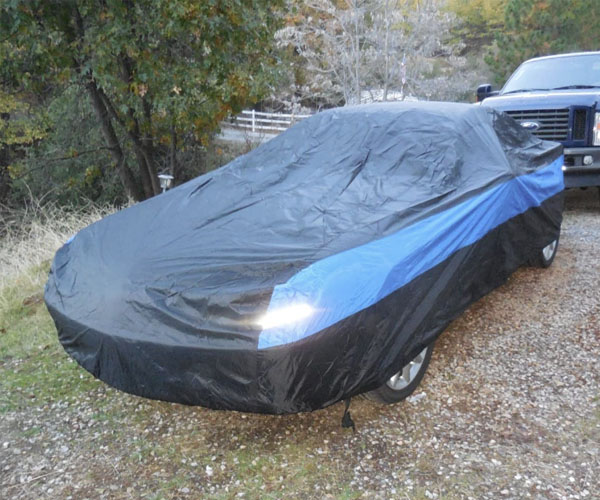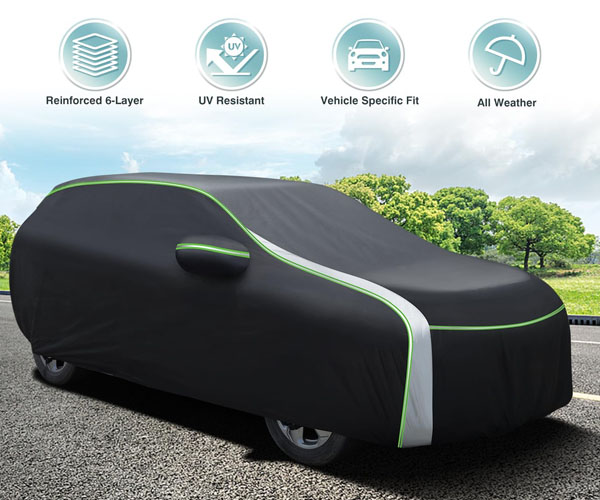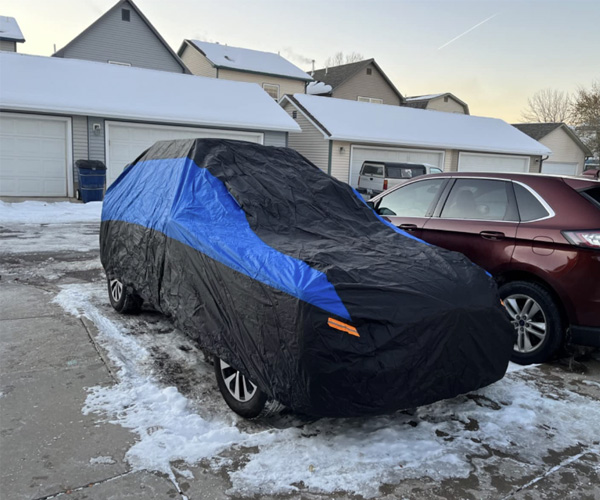Indoor vs. outdoor Ford Explorer car covers
I. Introduction
Purchasing a Ford Explorer is an investment in both design and utility, but safeguarding this purchase necessitates being aware of the subtleties of automobile maintenance, especially when it comes to selecting the appropriate car cover. We explore the important distinctions and factors to take into account between indoor and outdoor vehicle covers for your Ford Explorer in this extensive article. Whether you park your car in a small garage or leave it outside in the weather, choosing the right cover is crucial to keeping it looking brand new. We’ll go over many features of both indoor and outdoor Ford Explorer car covers in the upcoming sections so you can make an informed choice that suits your needs.
This in-depth discussion will address:
- Material Differences:
- Indoor covers are often lighter, designed for dust protection and preventing minor nicks and scratches.
- Outdoor covers, on the other hand, are built to withstand harsh weather conditions, including rain, snow, and UV rays.
- Protection Levels:
- Explore how indoor covers primarily guard against indoor hazards like dust and moisture.
- Understand the robust protection offered by outdoor covers against environmental elements like bird droppings, tree sap, and weather extremes.
- Breathability and Water Resistance:
- Learn about the breathability factor in indoor covers that prevents moisture accumulation.
- Discover the water-resistant technologies in outdoor covers that protect your Ford Explorer from rain and snow.
- Fit and Convenience:
- Discuss the snug fit offered by indoor covers, ideal for the compact spaces of indoor garages.
- Contrast with the sturdy, sometimes bulkier, fit of outdoor covers designed to stay secure in windy conditions.
- Aesthetic Appeal:
- Delve into the variety of styles and colors available in both indoor and outdoor covers, emphasizing personalization and aesthetic appeal.
- Durability and Longevity:
- Indoor covers may require less durability, but understand why material quality still matters.
- Examine the enhanced durability required for outdoor covers to ensure long-term protection against the elements.
- Cost Considerations:
- Compare the pricing of indoor versus outdoor covers, and discuss the investment in relation to the level of protection offered.
- Maintenance and Care:
- Highlight the ease of maintenance for indoor covers.
- Address the additional care and cleaning needed for outdoor covers due to their exposure to harsher conditions.
You will have a complete grasp of the benefits and drawbacks of both indoor and outdoor car coverings for your Ford Explorer by the end of this article, allowing you to select a cover that not only fits your vehicle but also your needs and the requirements of your surroundings.
II. Understanding Car Covers: A Primer
When venturing into the realm of auto covers, especially for a car as durable and adaptable as the Ford Explorer, it’s critical to understand the basic distinctions and features that these coverings provide. Understanding the difference between indoor and outdoor covers is essential. While shielding your car is a vital function of both types, their designs and material composition are tailored to suit various dangers and situations.
- Indoor Car Covers:
- Purpose: Primarily designed to shield the vehicle from indoor hazards, such as dust, moisture, and accidental scratches that can occur in garages or storage areas.
- Material: Typically made from lightweight, breathable fabrics. These materials prevent dust accumulation and allow moisture trapped on the car’s surface to evaporate, reducing the risk of rust.
- Fit and Form: Often more form-fitting, as protection against weather elements is not a priority. The snug fit ensures minimal movement, which is crucial to avoid scratches.
- Key Considerations: Ideal for car owners who store their Ford Explorers in enclosed spaces. Not suitable for outdoor use as they offer limited protection against harsh weather conditions.
- Outdoor Car Covers:
- Purpose: Engineered to provide comprehensive protection against a range of outdoor elements, including harsh sunlight, rain, snow, and even bird droppings.
- Material: Constructed from more robust, weather-resistant materials. These covers are often treated with UV-resistant coatings and are waterproof or water-resistant to withstand diverse weather conditions.
- Fit and Form: While still offering a good fit, outdoor covers are generally a bit looser than indoor covers to facilitate better air circulation, preventing condensation and mold growth.
- Key Considerations: A must-have for those who frequently park their Ford Explorers outdoors. The material’s durability and protective features are critical in choosing the right cover.
When deciding between indoor and outdoor Ford Explorer car covers, take into account the particular risks you wish to shield your car from as well as the usual parking situations. For example, an outside cover with strong weather protection is necessary if your Ford Explorer is used every day and is kept outside. If, however, your car is a prized collector’s item that is kept indoors, then a plush, form-fitting interior cover is more fitting.
Some Ford Explorer owners may also find it beneficial to have both kinds of covers. For instance, an indoor cover might be utilized when the car is kept in a garage for long periods of time, but an outdoor cover is better for daily use. Maximum protection is guaranteed in every situation thanks to this dual strategy.
Recall that a proper car cover greatly extends the life and upkeep of your Ford Explorer in addition to maintaining its visual attractiveness. You may choose the ideal car cover type and guarantee that your Ford Explorer stays in perfect shape for many years to come by being aware of the unique requirements and environmental challenges your car confronts.
III. Indoor Car Covers for Ford Explorer
A. Characteristics of Indoor Car Covers
The Ford Explorer indoor car covers are made with special characteristics to protect your car when it’s parked indoors. These covers are very different from outdoor covers in that they prioritize not so much weather protection as they do dust collection and scratch prevention. The following are the salient features:
- Material Softness and Breathability:
- Indoor covers are typically made from softer, more breathable materials.
- This ensures that any moisture trapped under the cover can easily evaporate, preventing mold or mildew formation.
- Soft fabrics like cotton or poly-cotton blends are common, providing a gentle touch to avoid any scratches on the Ford Explorer’s paintwork.
- Lightweight and Easy to Handle:
- Unlike outdoor covers, indoor covers are lightweight and easy to fold.
- Their lightness makes them easy to install and remove, a convenient feature for daily use.
- Dust and Minor Protection:
- The primary role of an indoor cover is to keep dust and dirt off the vehicle.
- They may also provide a buffer against minor knocks and scrapes that can occur in a garage setting.
- Custom Fit:
- Many indoor covers are custom-fitted to the Ford Explorer’s dimensions.
- A snug fit ensures comprehensive coverage and prevents the cover from slipping or bunching up.
- Aesthetic Appeal:
- Indoor covers often come in a variety of colors and patterns, allowing owners to maintain the aesthetic appeal of their vehicle even when covered.
- Limited Weather Protection:
- While they provide minimal weather protection compared to outdoor covers, they are suitable for the controlled environment of a garage or storage facility.
Comparing Indoor vs. Outdoor Covers
When considering Indoor vs. outdoor Ford Explorer car covers, it’s important to understand their distinct functions:
- Protection Focus:
- Outdoor covers are designed to protect against harsh weather conditions, UV rays, and outdoor pollutants.
- Indoor covers focus on protecting against dust, moisture, and minor indoor hazards.
- Material Differences:
- Outdoor covers are usually made from heavier, more durable materials with weatherproofing treatments.
- Indoor covers prioritize softness and breathability over ruggedness.
- Usage Frequency:
- If you frequently use your Ford Explorer, an indoor cover is more practical due to its ease of handling and lightweight nature.
- For long-term outdoor storage, an outdoor cover is essential for comprehensive protection.
- Customization Options:
- Both indoor and outdoor covers can be customized, but indoor covers often offer more aesthetic options.
- Cost Considerations:
- Generally, indoor covers are less expensive than their outdoor counterparts due to the difference in material and protection level.
In conclusion, your storage conditions and protection requirements will play a major role in your decision between an indoor and outdoor cover for your Ford Explorer. For cars kept in garages, indoor covers provide convenience and enough protection; for automobiles left outside in the weather, outdoor covers are necessary. Knowing these distinctions will guarantee that, wherever it is parked, your Ford Explorer is properly secured and retains its attractive appearance.
B. Benefits of Using Indoor Car Covers
There are several advantages to using indoor car coverings for Ford Explorer vehicles over outdoor ones, particularly when contrasting the former with the latter. These advantages draw attention to the subtleties of indoor storage in addition to highlighting the vehicle’s protection. It’s important for Ford Explorer owners who primarily park their vehicles indoors to comprehend these benefits.
- Preventing Dust and Debris Accumulation:
- Indoor environments, though seemingly controlled, can accumulate dust and other fine particles over time. Using an indoor car cover for your Ford Explorer ensures that these particles do not settle directly on the vehicle’s surface. This is particularly important for maintaining the car’s aesthetic appeal and ensuring that the paint remains unblemished.
- Moisture and Humidity Control:
- Even in indoor settings, cars can be exposed to varying levels of humidity, which might lead to rust or mildew if not properly managed. Quality indoor car covers are designed to be breathable, allowing moisture to escape and thus protecting the vehicle from the harmful effects of trapped humidity.
- Safeguarding Against Accidental Scratches and Dings:
- In garages or storage spaces, there’s always a risk of accidental scratches and minor dings from moving objects, tools, or even other vehicles. An indoor car cover acts as a protective layer, reducing the likelihood of such incidental contact damaging your Ford Explorer’s exterior.
- Maintaining Paint Quality:
- Continuous exposure to air and environmental factors, even indoors, can gradually deteriorate a car’s paint quality. Indoor car covers for the Ford Explorer help in preserving the paint by providing a stable, controlled environment, thus keeping the paint fresh and vibrant for longer periods.
- Added Security:
- While not as exposed as in outdoor settings, indoor-parked cars can still benefit from the added layer of security an indoor cover provides. It acts as a deterrent against potential tampering or theft, as the cover makes accessing the vehicle more cumbersome and time-consuming.
- Ease of Use and Customization:
- Indoor car covers are typically lighter and easier to handle, making them convenient to put on and take off. This is important for Ford Explorer owners who use their vehicle regularly. Moreover, these covers offer a range of customization options, allowing owners to choose covers that complement their vehicle’s style and their personal preferences.
In conclusion, it’s critical to select the appropriate interior vehicle cover for your Ford Explorer. It provides useful advantages in terms of protection and security in addition to helping to preserve the vehicle’s state and appearance. These special interior benefits should be taken into account when comparing indoor and outdoor Ford Explorer car covers so that you can make an informed choice that meets your car’s storage and maintenance requirements.
C. Best Practices for Indoor Car Cover Use
There are a few best practices to follow when applying indoor car coverings for your Ford Explorer in order to provide optimal protection and preserve the vehicle’s appearance. It is essential to comprehend the distinctions between indoor and outdoor Ford Explorer vehicle covers in order to choose the appropriate cover and utilize it efficiently. The following are some essential rules:
- Choosing the Right Material:
- Opt for breathable fabrics that allow air circulation, preventing moisture buildup which can lead to mold or rust.
- Lightweight materials are ideal for indoor use as they are easier to handle and less abrasive against the car’s paint.
- Proper Cover Fitting:
- Ensure the cover fits snugly but not too tightly; a too-tight cover can cause scratches, while a loose one can gather dust and debris.
- Covers specifically designed for the Ford Explorer are preferable, as they accommodate the vehicle’s dimensions and unique features.
- Cleaning and Maintenance:
- Regularly clean the cover to prevent dust accumulation. Machine-washable covers are a practical choice.
- Inspect your Ford Explorer and the cover periodically for any signs of wear or damage.
- Vehicle Preparation:
- Clean and dry your Ford Explorer thoroughly before covering; this prevents dirt particles from scratching the paint.
- Pay attention to removing substances like bird droppings or tree sap, which can be corrosive if left under the cover.
- Environmental Considerations:
- Even when parked indoors, consider factors like humidity, temperature fluctuations, and potential pest infestations.
- Use desiccants or a dehumidifier in very humid environments to protect both the car and the cover.
- Ease of Use:
- Choose a cover that is easy to put on and take off. This encourages regular use, especially if you use your Ford Explorer frequently.
- Storage bags or straps are helpful for keeping the cover tidy and compact when not in use.
- Combining Indoor and Outdoor Protection:
- If your Ford Explorer is occasionally parked outdoors, consider a cover that offers basic outdoor protection while still being suitable for indoor use.
- Look for features like mild water resistance or UV protection in such cases.
You may properly secure your Ford Explorer with an indoor vehicle cover by adhering to these best practices. Recall that the secret is to strike a balance between the necessity for protection and use, making sure the cover accomplishes its goal without being a burden. When it comes to Ford Explorer car covers, indoor ones are more important than outside ones because they preserve the vehicle’s aesthetics while shielding it from dust, interior pollution, and small physical damage. Any Ford Explorer owner should consider investing in these covers since they will contribute to the preservation of the vehicle’s longevity and aesthetic appeal with proper care and use.
IV. Outdoor Car Covers for Ford Explorer
A. Characteristics of Outdoor Car Covers
It’s critical to comprehend the primary differences between outdoor and indoor car covers for the Ford Explorer before making a decision. These features are made especially to safeguard your car in different outside conditions. We’ll examine these features in more detail below, keeping in mind our comparison of Ford Explorer vehicle coverings for indoor and outdoor use.
- Material Durability and Weather Resistance:
- Outdoor covers are crafted from materials that are substantially more robust than those used for indoor covers. They are engineered to withstand harsh weather conditions, such as intense sun, heavy rain, snow, and wind.
- The materials often have multiple layers, each serving a specific purpose like water resistance, UV protection, and breathability.
- For instance, a typical outdoor cover might feature a breathable layer to prevent moisture accumulation, a waterproof layer to repel rain, and a UV-resistant layer to protect against sun damage.
- Enhanced Protective Features:
- Unlike indoor covers, outdoor covers often come with additional protective features. These might include reinforced grommets for secure fastening during windy conditions, and elastic hems for a snug fit.
- Some outdoor covers are equipped with padded layers to offer extra protection against physical impacts, such as falling branches or hail, which is particularly important for the Ford Explorer given its common use in varied terrains.
- Customization for Specific Climates:
- Depending on the specific climate you live in, the outdoor cover for your Ford Explorer can be customized. For instance, covers for sunnier climates are designed with exceptional UV protection, whereas those for snowy areas have enhanced waterproofing and weight-bearing capacities.
- This customization is a crucial aspect to consider when comparing indoor vs. outdoor Ford Explorer car covers, as the requirements vastly differ based on the environment.
- Size and Fit:
- The fit of an outdoor cover is generally more precise than that of an indoor cover. This is because outdoor covers need to stay securely in place under adverse weather conditions.
- Many outdoor covers for the Ford Explorer are designed with a custom-fit in mind, ensuring that every part of the vehicle is adequately protected, from the roof to the wheels.
- Breathability:
- A key feature of outdoor covers, often overlooked, is breathability. A breathable cover allows moisture and heat to escape, preventing issues like mold, mildew, and corrosion.
- This is particularly important for the Ford Explorer, as the vehicle might be subjected to prolonged periods under the cover, and trapped moisture can lead to damage over time.
In summation, it’s critical to take into account these distinguishing features while deciding between indoor and outdoor Ford Explorer vehicle coverings. Outdoor coverings provide cutting-edge protection designed to endure environmental obstacles. They guarantee that your Ford Explorer is protected from the elements, preserving both its structural integrity and visual attractiveness. This degree of security is essential, particularly if the car is driven outside on a frequent basis.
B. Benefits of Using Outdoor Car Covers
It’s important to understand the differences between indoor and outdoor Ford Explorer car covers. Each has a distinct function, and knowing the advantages of each—particularly for outdoor use—will help you make a more informed choice. The following are some major benefits of covering your Ford Explorer with an outdoor car cover:
- Enhanced Protection Against Environmental Elements:
- Outdoor car covers are specifically designed to withstand harsh external elements.
- They provide robust protection against rain, snow, UV rays, and bird droppings, which can be particularly detrimental to your Ford Explorer’s exterior.
- By using an outdoor cover, you significantly reduce the risk of paint fading, rust, and other damage caused by prolonged exposure to the environment.
- Customized Fit for Maximum Coverage:
- Many outdoor covers are tailored to fit the unique contours of the Ford Explorer, ensuring every part of the vehicle is protected.
- A snug fit prevents the cover from flapping in the wind, which can cause scratches and wear over time.
- The right fit also means better protection against dust and dirt, keeping your Ford Explorer clean and well-maintained.
- Security and Theft Deterrence:
- An outdoor car cover can act as a deterrent to potential thieves.
- Covers conceal your vehicle’s make and model, making it less of a target.
- Some outdoor covers come with lockable cables, adding an extra layer of security for your Ford Explorer.
- Ease of Use and Convenience:
- Modern outdoor car covers are designed for ease of use.
- Lightweight materials and simple fastening systems mean you can quickly cover and uncover your Ford Explorer, making it a convenient daily use accessory.
- Many covers are also foldable, allowing for easy storage when not in use.
- Long-Term Cost Savings:
- By safeguarding your vehicle against the elements and potential damage, an outdoor cover can save you money on maintenance and repairs.
- The initial investment in a high-quality cover can offset the costs associated with paint jobs, bodywork, and other exterior maintenance tasks.
When contrasting Ford Explorer car covers—outdoor and indoor—it becomes clear that those who often park their cars outside need the latter. They provide a layer of defense that interior covers are unable to provide, particularly against the variable and frequently unpredictable external weather. Selecting an appropriate outdoor cover for your Ford Explorer is essential if you want to preserve its durability, keep it looking good, and make sure it stays safe outside.
C. Best Practices for Outdoor Car Cover Use
To guarantee optimal protection and longevity of the cover and your Ford Explorer, it is essential to comprehend recommended measures while choosing and applying outdoor car covers. These procedures are especially crucial when taking into account the variations between Ford Explorer vehicle covers for indoor and outdoor use. Outside coverings provide specific protection that inside covers cannot, as they are made to resist harsher weather.
- Choose Material Wisely:
- Heavy-Duty Fabrics: For outdoor use, opt for heavy-duty materials that offer robust protection against weather elements.
- Breathability: Ensure the fabric is breathable to prevent moisture buildup, which can lead to mold or rust.
- UV Protection: Look for covers with UV inhibitors to protect your Ford Explorer from sun damage.
- Proper Fitting is Key:
- Custom Fit: A custom-fit cover is ideal for outdoor use as it provides snug protection without leaving any part of the vehicle exposed.
- Grommets and Ties: Ensure the cover has grommets and ties for secure fitting, especially important in windy conditions.
- Regular Maintenance:
- Cleaning: Regularly clean the cover to remove dirt and debris that can scratch the car’s surface.
- Inspection: Periodically inspect the cover for wear and tear, especially in areas prone to high stress.
- Mindful Placement:
- Avoid Sharp Objects: When covering your Ford Explorer, ensure there are no sharp points or edges that could tear the cover.
- Smooth Surface: Place the cover on a clean and smooth surface of the car to avoid trapping particles that could scratch the paint.
- Seasonal Considerations:
- Winter Protection: In snowy regions, choose a cover with excellent waterproofing and weight to withstand snow accumulation.
- Summer Care: In hot climates, a cover with reflective properties can help keep the vehicle cool and prevent paint fading.
- Security Measures:
- Lockable Covers: Some outdoor covers come with lockable features for added security against theft.
- Visibility: Reflective strips or bright colors can enhance the visibility of your covered Ford Explorer, adding a safety aspect.
- Ease of Use:
- Storage: Choose a cover that is easy to fold and store when not in use.
- Handling: Ensure the cover is manageable in terms of weight and size for easy application and removal.
- Comparing with Indoor Covers:
- Indoor vs. Outdoor: Understand the differences between indoor and outdoor covers. Indoor covers are typically lighter and intended for dust protection, whereas outdoor covers are built to withstand harsher elements.
In conclusion, careful material selection, fitting, upkeep, and placement are critical when it comes to safeguarding your Ford Explorer with an outdoor car cover. Taking into account the distinct requirements for indoor versus outdoor Ford Explorer car covers guarantees that your automobile is kept safe in every setting, preserving its longevity and attractive appearance.
V. Key Differences Between Indoor and Outdoor Covers
The choice you make when examining the differences between indoor and outdoor Ford Explorer car coverings is mostly dependent on the types of risks you expect to experience and where you park your Ford Explorer most of the time. The differences between these two kinds of coverings lie not only in their intended usage but also in the unique characteristics and composition that suit various kinds of surroundings.
- Material Composition:
- Indoor Covers:
- Typically made from lightweight, breathable fabrics.
- Designed to protect against dust, minor knocks, and scratches prevalent in garages or storage spaces.
- Often softer and less abrasive to the car’s paint.
- Outdoor Covers:
- Constructed from heavier, more durable materials.
- Engineered to withstand external elements like UV rays, rain, snow, and bird droppings.
- Usually features water-resistant or waterproof coatings.
- Indoor Covers:
- UV Protection:
- Indoor Covers:
- UV protection is generally not a priority since the vehicle is shielded from direct sunlight.
- Outdoor Covers:
- Essential to have UV inhibitors in the fabric to prevent paint fading and other sun-related damage.
- Indoor Covers:
- Water Resistance:
- Indoor Covers:
- Water resistance is not a critical feature for indoor covers.
- Focus is more on breathability to prevent moisture buildup.
- Outdoor Covers:
- Must have high water resistance to protect against rain and snow.
- However, they should still be breathable to prevent moisture accumulation under the cover, which could lead to rust or mold.
- Indoor Covers:
- Fit and Security:
- Indoor Covers:
- Fit can be more relaxed as protection from movement or wind is not a concern.
- Outdoor Covers:
- Often come with additional security features like elastic hems, grommets, or ties for a snug fit.
- Helps the cover stay in place during windy conditions and offers some theft deterrence.
- Indoor Covers:
- Climate Considerations:
- Indoor Covers:
- Less affected by regional climate variations.
- Outdoor Covers:
- Needs vary significantly based on climate; for example, covers in sunny, dry areas require different features compared to those used in colder, wetter climates.
- Indoor Covers:
- Durability and Lifespan:
- Indoor Covers:
- Generally have a longer lifespan due to less exposure to harsh elements.
- Outdoor Covers:
- Exposed to more rigorous conditions, thus might need replacement more frequently.
- The quality and durability of the material play a crucial role in how well they endure over time.
- Indoor Covers:
- Ease of Use and Maintenance:
- Indoor Covers:
- Easier to manage and clean due to their lightweight nature.
- Outdoor Covers:
- Might require more effort to install and remove due to their bulk and the need to secure them properly.
- Cleaning and maintenance might be more demanding due to exposure to outdoor elements.
- Indoor Covers:
In conclusion, in order to provide your Ford Explorer the best possible protection, you must take these important factors into account while deciding between indoor and outdoor car covers. Choosing the proper cover type is essential to preserving the longevity and aesthetic appeal of your Ford Explorer, regardless of whether it is kept outside or parked in a warm garage.
VI. How to Choose the Right Cover for Your Ford Explorer
A. Assessing Your Needs
It’s important to evaluate your unique demands and take into account a number of elements that may influence your choice when selecting the appropriate cover for your Ford Explorer. This evaluation will help you choose an insurance that fits your usage habits and lifestyle in addition to protecting your car. Crucial aspects to pay attention to are:
- Environment and Climate:
- Indoor vs. outdoor Ford Explorer car covers play a pivotal role depending on where you usually park your vehicle.
- For indoor settings, look for covers that provide basic dust and scratch protection. Materials like lightweight polyester are ideal, offering breathability and preventing moisture accumulation.
- In contrast, outdoor parking demands more robust features. Here, you need a cover that withstands diverse weather conditions, from intense sun and heat to heavy snow and rain.
- Frequency of Use:
- Consider how often you will be using and removing the cover. If you’re a daily user, opt for a cover that is easy to handle and quick to fold.
- For long-term storage, durability and protection against environmental factors become more crucial. Heavier, multi-layered covers might be more appropriate in such cases.
- Customization Needs:
- Reflect on the extent of customization you desire. Some Ford Explorer owners prioritize aesthetics, seeking covers that complement the vehicle’s color and design.
- Custom-fit covers, though more expensive, ensure a snug fit, enhancing both protection and style. They reduce the risk of the cover flapping in the wind, which can lead to wear and tear or even paint scratches.
- Special Features:
- Security features are another consideration. If you park in a public or high-risk area, a cover with lockable cables can deter theft.
- UV protection is crucial for maintaining the paint quality of your Ford Explorer, especially in sunny climates.
- Water resistance is important for rainy areas but ensure the cover is also breathable to prevent mold and mildew formation.
You may choose the ideal kind of vehicle cover for your Ford Explorer by carefully weighing these factors. Keep in mind that purchasing the proper cover is an investment in your car’s upkeep and longevity.
B. Considering Customization Options
Understanding the different customization choices is essential when choosing the perfect vehicle cover for your Ford Explorer. These choices guarantee that the cover fits your unique requirements and tastes while also improving its efficacy. Here, we explore the customization options, paying special attention to the variations and uses of Ford Explorer vehicle coverings for indoor and outdoor use.
- Material Choices for Different Environments:
- Indoor Covers:
- Typically lighter, designed for dust and minor abrasions protection.
- Materials like soft polyester or cotton blends are common, offering breathability and preventing moisture buildup.
- Outdoor Covers:
- Heavier and built to withstand harsher elements like UV rays, rain, snow, and bird droppings.
- Materials such as multi-layer polypropylene or polyester with weatherproof coatings are preferred for their durability and water resistance.
- Indoor Covers:
- Design Aspects for Indoor and Outdoor Covers:
- Indoor Covers:
- Often sleeker and more form-fitting as they are less exposed to extreme conditions.
- Aesthetics play a larger role; options for custom prints or colors to match the car or garage interior are available.
- Outdoor Covers:
- Features like reflective strips for visibility, tie-down grommets for wind protection, and reinforced seams for extra strength are common.
- Typically designed with more generic shapes to accommodate a range of external conditions.
- Indoor Covers:
- Customization for Specific Needs:
- Tailoring for climatic conditions: A cover for sunny, dry areas might prioritize UV protection, while one for snowy regions would focus on insulation and water resistance.
- Considering the frequency of use: For daily drivers, a lightweight, easy-to-handle cover is ideal. For long-term storage, a more robust cover may be necessary.
- Key Considerations in Customization:
- Fit and Size: Custom or semi-custom fits ensure the cover aligns perfectly with the Ford Explorer’s dimensions, providing optimal protection.
- Additional Features: Ventilation pockets to prevent mold, mirror pockets for a snug fit, and clear panels for license plates are some considerations.
- Balancing Indoor and Outdoor Needs:
- For those requiring both indoor and outdoor protection, consider a cover with a balance of features – moderate weather resistance with some focus on aesthetics.
- Alternatively, owning two separate covers, one for each condition, ensures maximum protection and longevity of both the cover and the vehicle.
In conclusion, carefully evaluating your unique demands and surroundings is necessary when deciding between indoor and outdoor Ford Explorer car covers. Whether it’s stored in your garage or out in the weather, your Ford Explorer will always be secured in style thanks to customization options that provide a personalized approach. You can give your car the greatest possible maintenance by giving the appropriate materials, design cues, and extra features top priority.
VII. Installation and Maintenance Tips
To maximize the usefulness and longevity of Ford Explorer vehicle covers, it is essential to understand proper installation and maintenance procedures. This section will concentrate on advice specific to indoor and outdoor covers, stressing the variations in maintenance and use to guarantee your cover stays in excellent shape.
- Initial Installation Tips
- Outdoor Covers:
- Check for Debris: Before placing an outdoor cover on your Ford Explorer, ensure the car’s surface is free of dirt and debris to prevent scratches.
- Secure Attachment: Outdoor covers should have a snug fit and secure attachments to withstand wind and weather elements.
- Weather Consideration: If installing in windy conditions, start from the front or rear of the vehicle and gradually work your way around, securing the cover as you go.
- Indoor Covers:
- Gentle Placement: Since indoor environments are more controlled, place the cover gently over your Ford Explorer, ensuring even coverage.
- Looser Fit: Indoor covers can be a bit looser as they don’t need to combat wind and harsh weather.
- Outdoor Covers:
- Maintenance Tips for Longevity
- Cleaning Your Cover:
- Frequency: Regular cleaning is vital, especially for outdoor covers exposed to more dirt and pollutants.
- Method: Use mild detergent and lukewarm water for both indoor and outdoor covers. Avoid harsh chemicals that can degrade the fabric.
- Air Dry: Always air dry the covers; do not use a machine dryer as high heat can damage the material.
- Inspection and Repair:
- Regular Checks: Inspect your cover periodically for tears or wear, especially if used outdoors.
- Repairing Minor Damage: Small rips or holes can often be repaired with a simple patch kit designed for the specific material of your cover.
- Cleaning Your Cover:
- Seasonal Adjustments
- Outdoor Cover Adjustments:
- Winter: For snowy areas, choose a cover with extra waterproofing and weight to handle snow accumulation.
- Summer: Look for covers with UV protection to prevent fading and heat damage.
- Indoor Cover Adjustments:
- Dust Protection: In dusty environments, ensure your indoor cover is more snug to prevent dust particles from settling on the vehicle.
- Outdoor Cover Adjustments:
- Storage Tips When Not in Use
- Proper Folding: Fold the cover neatly when not in use to prevent creases or damage.
- Storage Location: Store in a dry, cool place away from direct sunlight. Outdoor covers should be stored indoors if possible to avoid additional environmental exposure.
- Comparing Indoor vs. Outdoor Ford Explorer Car Covers
- Material Differences: Outdoor covers are typically made from more robust, weather-resistant materials, while indoor covers are softer and more focused on preventing dust and minor scratches.
- Use-Case Scenarios: Choose the cover based on where your Ford Explorer is predominantly parked. If it’s typically outside, invest in a high-quality outdoor cover; if it’s garaged, a lighter indoor cover may suffice.
You can guarantee that your Ford Explorer car cover, whether it is installed indoors or outdoors, offers the best protection and holds up over time by following these installation and maintenance guidelines. Recall that proper handling and maintenance can greatly increase the lifespan of your car cover, making it an affordable addition to your automobile.
VIII. Case Studies and User Experiences
The easiest way to demonstrate the significant influence car covers have on the Ford Explorer’s protection and style is to utilize actual examples and user experiences. We explore the experiences of Ford Explorer owners who have chosen between indoor and outdoor car covers in this section. Their experiences demonstrate how important it is to choose the appropriate cover type depending on personal preferences and local conditions.
- Case Study 1: Urban Dweller with Limited Parking
Situation: Living in a densely populated city, Mark had limited parking options for his Ford Explorer. He needed a cover that could protect against urban pollutants and minor scrapes from traffic. Solution: Mark opted for a lightweight, durable outdoor cover designed to resist abrasion and repel urban pollutants. Outcome: The cover not only protected his car from city grime and minor scratches but also maintained the vehicle’s sleek appearance. - Case Study 2: Suburban Homeowner with Garage
Situation: Emily, residing in a suburban area, had the luxury of a garage for her Ford Explorer. However, she wanted additional protection against dust and indoor elements. Solution: Emily chose a soft, breathable indoor cover, prioritizing dust protection and paint preservation. Outcome: The indoor cover kept her Explorer dust-free and maintained its pristine condition, enhancing its resale value. - Case Study 3: Coastal Resident Facing Harsh Weather
Situation: John’s residence near the coast exposed his Ford Explorer to salty air and occasional storms. Solution: He selected a heavy-duty outdoor cover with excellent water resistance and UV protection. Outcome: The cover shielded the vehicle from corrosive sea salt and weather elements, preserving both its functionality and aesthetic appeal. - Case Study 4: Frequent Traveler with Varied Environments
Situation: Lisa, who frequently travels, encountered various environmental conditions, from hot sun to snow. Solution: She invested in a versatile all-weather cover, offering balanced protection for both indoor and outdoor use. Outcome: Regardless of her location, the cover provided comprehensive protection, adapting to diverse weather conditions and ensuring her Explorer’s longevity. - Case Study 5: Classic Car Enthusiast and Collector
Situation: Alex, a collector of classic Ford Explorers, needed covers that would protect his vehicles from dust and moisture while in storage. Solution: Opting for custom-fit indoor covers, he ensured tailored protection against indoor hazards while showcasing the cars’ silhouettes. Outcome: The covers not only preserved the vehicles in showroom condition but also accentuated their classic lines and shapes.
These case studies highlight how important it is to select the appropriate vehicle cover. Whether choosing Ford Explorer car covers for indoor or outdoor use, each situation emphasizes how crucial it is to match the cover to certain environmental requirements and personal tastes. For Ford Explorer customers, these real-world examples offer insightful guidance that helps them make well-informed decisions on the safety and aesthetics of their car.
IX. Where to Buy Quality Car Covers for Ford Explorer
The key distinction between indoor and outdoor Ford Explorer car covers should be taken into account while looking for the ideal cover for your vehicle. There are many possibilities available on the market, but it takes considerable thought to identify a trustworthy supplier that can meet your unique requirements. Here are some essential points to help you decide what to buy:
- Understanding the Need: Indoor vs. Outdoor Covers
- Indoor Car Covers:
- Purpose: Designed primarily to protect against dust, minor abrasions, and to maintain the aesthetic appeal of the vehicle.
- Material: Often made from softer, lighter materials that are less abrasive to the car’s paint.
- Ideal for: Ford Explorers that are frequently parked in garages or covered spaces.
- Outdoor Car Covers:
- Purpose: Built to withstand harsher environmental conditions such as rain, snow, UV rays, and bird droppings.
- Material: Typically constructed from more durable, water-resistant, and UV-protected fabrics.
- Ideal for: Ford Explorers that are regularly exposed to outdoor elements.
- Indoor Car Covers:
- Where to Find Quality Car Covers
- Authorized Dealers:
- Pros: Offer genuine products that are often tailor-made for specific models like the Ford Explorer.
- Cons: Can be more expensive compared to other sources.
- Examples: Official Ford dealerships or licensed automotive accessory stores.
- Online Marketplaces:
- Pros: Wide range of options, competitive pricing, and the convenience of home delivery.
- Cons: The risk of encountering low-quality or counterfeit products.
- Recommendations: Reputable e-commerce platforms like Amazon, eBay, or specialized automotive accessory websites.
- Automotive Accessory Stores:
- Pros: Opportunity to physically inspect the cover for quality and fit.
- Cons: Limited stock variety compared to online options.
- Suggested Locations: Local or national automotive chains known for quality products.
- Authorized Dealers:
- Key Factors to Consider When Purchasing
- Quality of Material: Ensure it’s suitable for your specific need (indoor or outdoor).
- Fit and Ease of Use: A cover that is easy to put on and remove, and fits your Ford Explorer snugly.
- Warranty and Return Policy: Look for products with a warranty and a clear return policy for added assurance.
- Customer Reviews and Ratings: Insightful for real-world usage and satisfaction levels.
- Additional Services and Support
- Some retailers offer additional services like custom fitting, color customization, and even installation guides or support.
- Always check if the seller provides after-sales support, which can be invaluable in case of any issues with the product.
In conclusion, it’s critical to distinguish between indoor and outdoor needs when buying a car cover for your Ford Explorer because these factors have a big impact on the kind of cover needed. Purchasing from reliable providers guarantees that you obtain a product that successfully balances style and protection. Quality, durability, and fit are crucial. Recall that purchasing a high-quality car cover helps to protect your automobile’s worth over time in addition to keeping it in good shape.
Frequently Asked Questions
Are car covers better indoor or outdoor?
The suitability of car covers depends on where you park your vehicle regularly. Indoor car covers are lightweight and designed to protect against dust and minor scrapes, ideal for garage-kept vehicles. Outdoor car covers are more robust, offering protection against weather elements, such as rain, UV rays, and bird droppings. Thus, neither is better overall; it’s about the right cover for the right environment.
Can an indoor car cover be used outside?
An indoor car cover can be used outside but it may not offer adequate protection. These covers are typically made from materials that protect against dust and scratches rather than water, UV, or extreme temperatures. Using an indoor cover outdoors can lead to damage from environmental factors it’s not designed to withstand.
Is it better to cover a car or leave it uncovered?
It is generally better to cover a car to protect it from environmental hazards like UV rays, bird droppings, and weather conditions that can damage the paint and finish over time. A cover also provides a barrier against scratches and dust, keeping the car cleaner and potentially reducing the frequency of washes.
What is an indoor car cover?
An indoor car cover is a protective layer designed specifically for use within covered or enclosed spaces, like garages. These covers are usually made from softer, breathable materials that protect the vehicle from dust, minor bumps, and scratches without damaging the paint.
Are indoor car covers a good idea?
Yes, indoor car covers are a good idea if you keep your car parked inside. They help to keep your vehicle dust-free and protect against accidental scrapes and scratches that can happen in a garage. They also maintain the vehicle’s aesthetic appeal by shielding the paint from potential indoor pollutants.
Why use an indoor car cover?
An indoor car cover is used to protect a vehicle from indoor hazards such as dust, pet hair, and minor dings or scratches that can occur when moving items around in a garage. They are also beneficial for maintaining the car’s paintwork, as they prevent the accumulation of dirt and grime that can lead to surface damage over time.
X. Conclusion
Summarizing the important distinctions and elements to take into account between indoor and outdoor car covers for the Ford Explorer, it is clear that the decision is based on a variety of criteria, all of which are crucial to the best possible protection and upkeep of your car. Knowing these differences is important for more reasons than just protecting your vehicle; it will help you make an informed choice that fits your needs as well as those of your Ford Explorer and the environment in which you live. The main conclusions are as follows:
- Understanding Your Needs:
- Indoor Car Covers:
- Ideal for garage-kept vehicles to protect against dust, minor abrasions, and indoor pollutants.
- Often lighter, softer, and more tailored for a snug fit.
- Outdoor Car Covers:
- Engineered to withstand harsh weather conditions like rain, snow, UV rays, and bird droppings.
- Typically heavier and equipped with more robust protective features.
- Indoor Car Covers:
- Material Matters:
- Indoor Covers:
- Made from softer, breathable materials like cotton or polyester blends.
- Focus on preventing scratches and dust accumulation.
- Outdoor Covers:
- Constructed with durable, weather-resistant materials like polypropylene or high-grade polyester.
- Often multi-layered for enhanced protection.
- Indoor Covers:
- Customization and Fit:
- Whether indoor or outdoor, the fit of the car cover on your Ford Explorer is crucial. Custom-fit covers provide the best protection and prevent moisture or debris accumulation.
- Maintenance and Longevity:
- Regular cleaning and correct storage of the car cover extend its life and maintain its protective qualities, irrespective of whether it’s an indoor or outdoor cover.
- Cost Considerations:
- Balancing budget with quality is essential. Outdoor covers might be more expensive due to their advanced features, but they offer more comprehensive protection against external elements.
- Making the Right Choice:
- Ultimately, your decision should be guided by the specific conditions your Ford Explorer is typically exposed to. If you regularly park outdoors in areas with extreme weather, an outdoor cover is indispensable. Conversely, for predominantly indoor parked vehicles, an indoor cover suffices.
In conclusion, there is no one-size-fits-all solution when it comes to indoor vs. outdoor Ford Explorer vehicle covers. Every kind has a distinct set of features made to meet various requirements for protection. Through a thorough evaluation of your individual and environmental needs, you can choose a cover that will protect your Ford Explorer in an efficient manner while preserving its appearance and potential to be sold. Keep in mind that purchasing the proper car cover is an investment in your automobile’s longevity and immaculate condition.

